Yves Klein – Master of the Color Blue
by David Fox
I was an extreme element of society who lived in space and who had no means of coming back to earth.
Yves Klein, one of the most prominent and controversial French artists, emerged in the middle of the XX century and is remembered above all else for his use of a single color – a rich shade of ultramarine that he made his own: International Klein Blue.
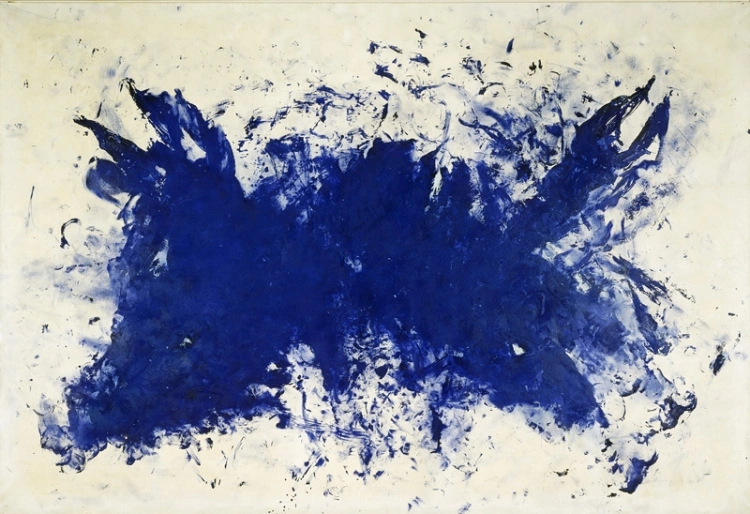
Serious Circumstances
Klein´s art emerged from serious circumstances. In the late 1940s, France was still a nation traumatized by World War II. The cultural center of gravity had moved across the Atlantic to New York. The artists who remained in Paris, or at least the good ones, were producing post-apocalyptic work, and out of the same rubble came the much younger Klein.
The abstract painting that dominated French art in the 1950s was invariably premised on the notion that an artist could communicate with the viewer through the power of abstract form. But the skeptics of modern abstract art have always alleged that the viewers, like the faithful devotees of a false god, do more of the than the artist, investing the forms with their own feelings rather than discovering the artist’s.
Klein was fascinated by mystical ideas, by notions of the infinite, the absolute, the indefinable and his use of a single rich and suggestive tone of blue might be seen as an attempt to free the viewer from all imposed ideas.
But he would turn out to be a very worldly mystic- a merry prankster and shrewd self-publicist, Klein was a unique combination of spiritual seeker and shameless showboat, an artist of metaphysical bent.
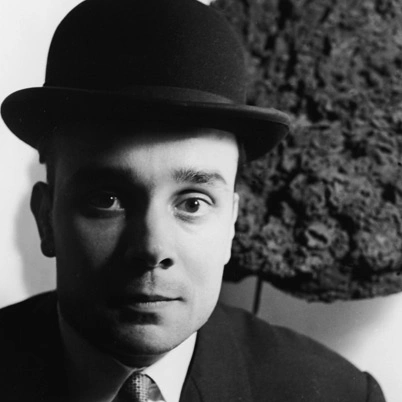
Background
Yves Klein was born on April, 28, 1928, in Nice, France to an artistic family, the son of two painters. His father, Fred Klein, a Dutch-Indonesian, worked in a figurative Post-Impressionist mode while his mother, Marie Raymond, a Frenchwoman, was a successful School of Paris abstractionist and a leading figure in the Informel movement.
Klein grew up shuttling between his parents in Paris and his grandparents in Nice.
Although Klein grew up in an artistic family, he did not receive formal artistic training. Between 1942 and 1946, he studied at the Ecole Nationale des Langues and the Ecole National de la Marine Marchand; during this time he became close friend with Armand Fernandez, a promising young sculptor, and Claude Pascal, a young poet.
The friends shared common interests of jazz music, literature, esotericism, Eastern religions and martial arts and judo especially. Klein´s sport was judo, which he wrote a book about, after studying it at Kadokan Institute in Tokyo (from 1947 and 1952/53) and earning a black belt.
Klein is certainly the only 20th century artist to have published a book titled The Foundations of Judo.

Thwarted By Judo
The refusal of the French Federation of Judo to recognize his Japanese diploma, in 1954, frustrated his career plans in that direction to the benefit of his career in art. An academic failure, Klein began making art on his own while taking odd jobs.
According to a story, Klein’s major artistic breakthrough happened in 1947 while lying on a beach with Pascal and Arman. The three friends divided the universe between themselves: Arman claimed the materiality of the earth, Pascal appropriated language and words and Klein possessed ‘’the void’’-the planet empty of all matter.
Klein embarked on a realistic-imaginative daydream into the depths of the universe, where he claimed to have inscribed his name in the sky.
The void enlightenment in the sky led Klein to experiment in painting, music and performance. The Monotone-Silence Symphony from 1949, a piece containing a single chord sustained for twenty minutes followed by twenty minutes of meditative silence.
It symbolized the sound pitch emitted from the monochrome blue sky, or the void emphasizing universal harmony.
New Sensations
In the period between 1848 and 1952, Klein lived in London and began to assist in London frame shop of Robert Savage, learning basic painting techniques and using raw pigments and gilding. He was determined to evoke sensations and emotions independent of line, abstracted symbols or rendered objects, believing the monochromatic surface released the painting from materiality through the totality of pure pigment.
In 1956, Klein had a controversial exhibition at the Galerie Colette Allendy in Paris, established himself in the Paris art scene. The exhibition titled Yves: Propositions Monochromes displayed twenty monochromatic paintings rendered in tones of blue, red, orange and yellow.
He received a pretty disappointing reaction from the public, who viewed the exhibition as a new form of interior abstraction rather than an infinite journey into the immateriality of the surface. After considering the public´s misinterpretation, Klein decided to push the monochrome a step further by focusing on his favorite color-blue.

Klein’s Blue Period
And, in 1956, he succeeded in suspending his favorite ultramarine pigment in petroleum extracts, which allowed the pigment to maintain its brilliance and something of its powdery texture without dulling. He named the substance International Klein Blue – IKB.
It was the beginning of the Klein´s Blue Period.
The piece Blue Monochrome, from 1957, is one of the Klein´s first monochromes featuring International Klein Blue. He depicted his vision, using only one color, a vibrant shade of ultramarine, which he later perfected for use with the aid of chemist. The painting contains no trace of imaginary or line, encouraging the viewer to immerse herself in the color alone and to experience its evocations.
Symbolic of the sky and sea had resonances in Klein´s own religion, Catholicism, as not only a symbol of the Holy Ghost, but also as the shade traditionally used in the depiction of the Virgin Mary’s robes in the Renaissance paintings.

In 1957, in Nice, Klein met the young beautiful German painter Rotraut Uecker, who assisted him on a huge decorative project for the Gelsenkirchen opera house, in Germany, involving canvases and sponge reliefs imbued with I.K.B.
Invisible Works
To further his artistic vision of the immaterial, he created Le Vide, or The Void (1958). He removed everything from the gallery space (Iris Clert Gallery) except for an empty cabinet; he also created a dramatic entrance for the opening show, in which visitors were welcomed into empty room.
In regards to the work, he stated that his paintings were invisible and he would like to show them in a clear and positive manner. The Void, like much of his work it might be read in a slightly contradictory manner, as a political attack on the traditional art object and the gallery system that supports it.
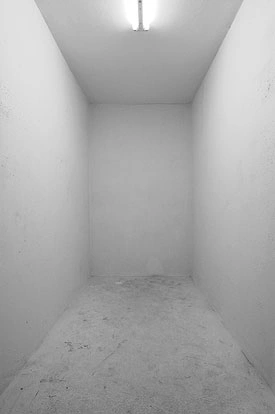
Venus Blue
In the Venus Blue, from 1960, Klein applied his signature International Klein Blue to a plaster cast of the famous Venus de Milo sculpture, pushing the monochrome into the three-dimensional field and establishing a relationship between the infinite cosmos and the human form.
By appropriating the famous Greek sculpture and painting it IKB, Klein gives the dated masterpiece a kind of kitsch and commercial appeal, making it a precursor to Pop Art.
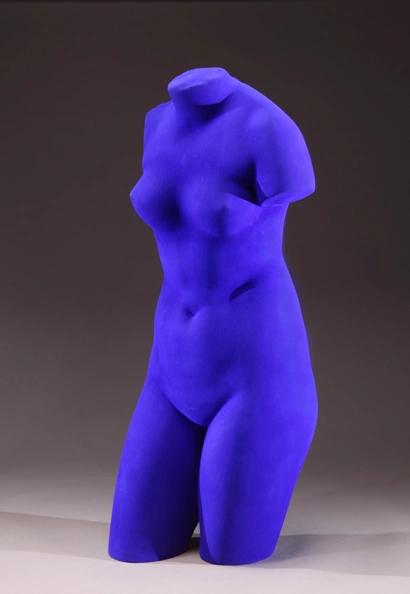
Anthropométrie sans titre
After concentrating on the monochrome canvases, Klein made a new departure with his signature IKB color, using his brush and nude models. In Anthropométrie sans titre, 1961, he covered nude females in blue paint and had them press, drag and lay themselves across canvases to create bodily impressions.
The piece was inspired in part by photographs of the body-shaped burn-marks on the earth, which were caused by the atomic explosion at Hiroshima and Nagasaki. Klein crafted this idea into a performance piece, hosting a formal event where guests observed the nude models executing the piece; although the events could be at times bizarre and comic, the resulting pictures represent a fresh and vivid approach to the idea of figurative painting darkly influenced by the threat of the Cold War.
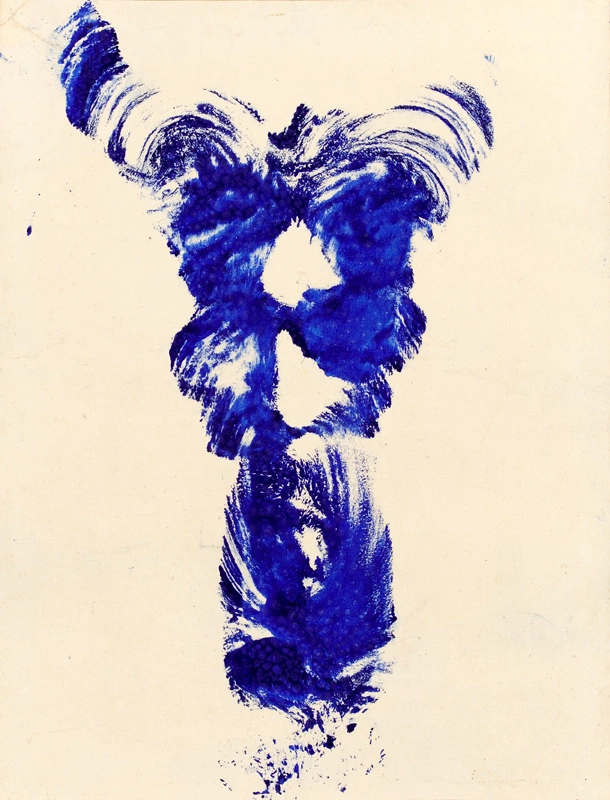
In this period, Klein became fascinated with natural elements and usually incorporated water, fire, sea sponges and gravel into his sculptures and canvases. This resulted in a series of fire paintings and monochrome relief paintings, as well as IKB sculptures that expressed cosmological ideas and infinite space.
After the exhibition at the Leo Castelli Gallery in New York, in 1961, he received a poor response and his paintings failed to sell.
Marriage to Rotraut Uecker & Death
The next year, he married Rotraut Uecker, several months before he died of a heart attack at the young age of 34.

In France, Klein perception of reality was significant forerunner of Nouveau Réalisme and a French strain of Pop Art. His work represents one of the most important responses to the monochrome in the art of the twenty century, and has joined the contributions of others such as Aleksander Rodchenko and Kasimir Malevich.
Yves Klein was a consummate trickster and more than a half of century after his death, we are still not sure how seriously to take him. As with Marcel Duchamp before him and the conceptual artists who came after, Klein believed that the idea behind a work was more important than the execution.
Among his earliest projects were two booklets he produced in 1954 that contained plates of his monochrome paintings – canvases covered over entirely in a single color. But while Klein by that year had produced some small monochromes, the particular paintings the booklets pretend to reproduce probably never existed.

About David Fox
David Fox is an artist who created davidcharlesfox.com to talk about art and creativity. He loves to write, paint, and take pictures. David is also a big fan of spending time with his family and friends.
Leave a Reply
 |
 |
 |
 |
Now get FREE Gifts. Or latest Free phones here.
Disable Ad block to reveal all the secrets. Once done, hit a button below
 |
 |
 |
 |